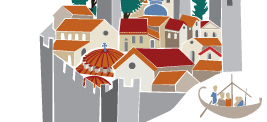Constantinople - Rome: "Constantine the Great"
Gnaeus Egnatius was a Roman senator who received the
title of proconsul after 146 BC. It was his appointment as governor of the
province of Macedonia that linked his name to one of the principal roads crossing
the Balkans, the Via Egnatia. This main trade route was the eastward extension
of Trajan’s road (Via Traiana), which ran southeast from Rome to end at Gnathia
(Egnatia), between the major ports of the Adriatic at Bari and Brindisi.
Gnathia had ferries to transport people and goods from the Italian peninsula to
the Balkan shores at the major port of ancient Epidamnos, renamed Durres after
the Roman conquest. Although the course of the Via Egnatia ran along older
Macedonian roads, it was constructed in line with all the technical features of
Roman road building. It passed close to cities old and new, such as Lychnidos
(Ohrid), Heraclea Lyncestis, Pella and Thessaloniki, where it ended, at least
during its first phase. It was however quickly expanded eastwards, to pass
through Rentina, Amphipolis, Philippi, Topeiros, Maximianoupolis, Traianoupolis
and as far as ancient Byzantium. The Via Egnatia was of tremendous military,
economic and commercial importance for the empire in Late Antiquity and
Byzantium, as it was the main road leading to the cities of the southern
Balkans. It was primarily used by the army, and of course by merchants, as a
relatively safe way to transport large quantities of goods from Rome and the
Italian Peninsula to Constantinople, at the entrance to the Black Sea.
After 315 Constantine no longer lived in Rome; he
returned only briefly in 326, to celebrate the twentieth year anniversary of
his reign. From as early as 319 he had decided to build a new city on the site of ancient Byzantium. In
324, as sole emperor, he gave it his name, offering his dynasty and the heirs
of his own empire a new capital. Constantinople was not designed to vie against
Rome - how could it? It was Constantine’s Rome.
Trail stops catalog
Bibliography (2)▼
Comments (0)▼
New Comment▼






